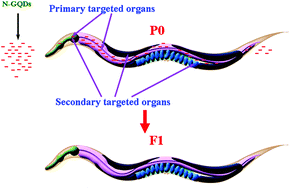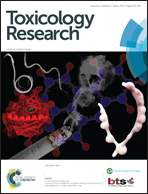Transgenerational safety of nitrogen-doped graphene quantum dots and the underlying cellular mechanism in Caenorhabditis elegans†
Abstract
Nitrogen-doped graphene quantum dots (N-GQDs) are of potential use for cellular imaging. We here employed the in vivo Caenorhabditis elegans assay system to investigate the transgenerational behavior of N-GQDs and the underlying cellular mechanism involved. Prolonged exposure to N-GQDs did not induce lethality, lifespan reduction, or change the functions of primary and secondary targeted organs in the wild-type nematode and in nematodes with mutations of the sod-2 or sod-3 genes that encode Mn-SODs. Moreover, no adverse effects were detected in progeny of N-GQD-exposed wild-type and mutant nematodes. N-GQDs were only distributed in the intestine of both wild-type and mutant nematodes. No N-GQD accumulation was observed in embryos and progeny of exposed nematodes. After N-GQD exposure, the normal biological state of the intestinal barrier and defecation behavior were maintained in the wild-type and mutant nematodes. We hypothesize that the physiological states of the intestinal barrier and defecation behavior may contribute greatly to the lack of translocation of N-GQDs into secondary targeted organs and progeny of exposed nematodes. Our data provide systematic in vivo evidence to indicate the transgenerational safety of N-GQDs and the underlying cellular mechanism.

- This article is part of the themed collection: Nanotoxicology

 Please wait while we load your content...
Please wait while we load your content...